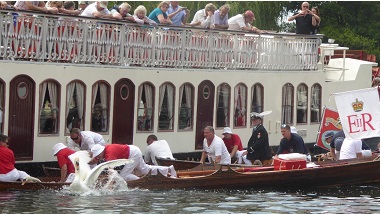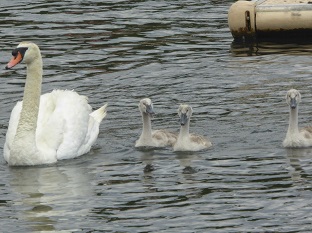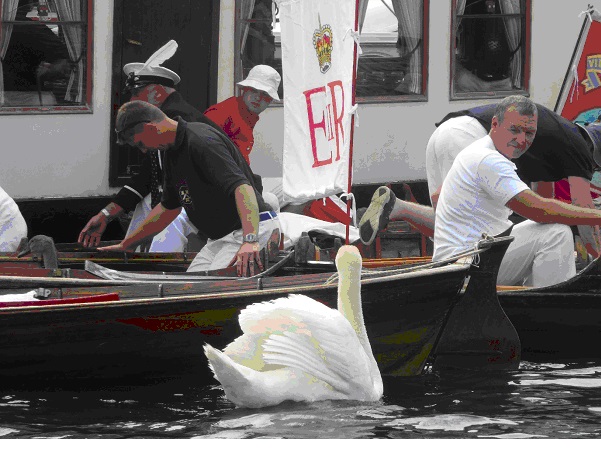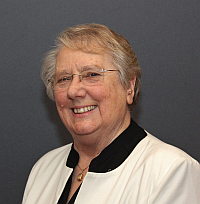The Mistress goes Swan Upping....
... and for the Sovereign marks, measures, weighs and identifies them...
The Mistress writes again…
Last week - courtesy of the Worshipful Company of International Bankers - the Master, The Learned Clerk and I went Swan Upping!


WHAT –do I hear you say - is that!?
Well, it involves boats and men in red, blue and white coats and has been happening for over 800 years.
To quote the "Royal life Magazine":
“The ceremony of Swan Upping takes place during the third week of July every year. Swan Upping dates from the twelfth century, when The Crown claimed ownership of all mute swans which were considered an important food source for banquets and feasts.
"The Crown retains the right of ownership of all unmarked mute swans in open water, but The Queen mainly exercises this right on certain stretches of the River Thames and its surrounding tributaries. This ownership is shared with the Vintners’ and Dyers’ Livery Companies who were granted rights of ownership by The Crown in the fifteenth century.
"The Queen’s Swan Marker and the accompanying Swan Uppers of the Vintners’ and Dyers’ Livery Companies use six traditional Thames rowing skiffs in their five-day journey upstream to Abingdon. By tradition, scarlet uniforms are worn by The Queen’s Swan Marker and Swan Uppers, and each boat flies the appropriate flag and pennant.
"The Sovereign’s Swan Marker counts the number of young cygnets each year. The cygnets are weighed and measured; examined for any sign of injury and any signs of disease and the cygnets are ringed with individual identification numbers.”

This is the nearest we got!
We started at Henley- in traditional Livery manner – with a glass of champagne; then travelled up river to meet the rowing skiffs. Before lunch the Uppers found a pair of swans and three cygnets. I was amazed at the dexterity with which the sometimes very vicious swans were contained and upped from the water. Not a job for me!
After lunch – I told you this was a traditional Livery event – five more birds were found; this time one adult really was protective of their young - but the Swan Uppers were not defeated.


What a wonderful day! History and boating on the Thames...
[ Key Facts about this magnificent bird: The mute swan is a very large white waterbird. It has a long S-shaped neck and an orange bill with a black base and a black knob. It flies with its neck extended and regular, slow wingbeats.
The population in the UK has increased recently, perhaps due to better protection of this species. The problem of lead poisoning on lowland rivers has also largely been solved by a ban on the sale of lead fishing weights. Some birds stay in their territories all year, while others move short distances and form winter flocks. In cold weather, some birds arrive from Europe into eastern England. ]
What they eat: Water plants, insects and snails. Measurements: Length: 140-160cm; Wingspan: 208-238 cm; Weight: 10-12 kg; Population: UK breeding: 6,400 pairs; UK wintering: 74,000 birds.

Mary Johnson, Mistress
